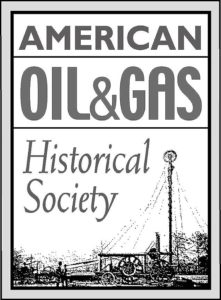April 29, 1942 – Tanker SS Mobiloil torpedoed in Atlantic –
A German U-boat torpedoed the unescorted steam tanker SS Mobiloil (spelled in some reports as Mobil Oil) in the Atlantic northeast of the Bahamas. During multiple torpedo attacks, U-108 surfaced and shelled the 10,000-ton tanker owned by the Socony-Vacuum Oil Company of New York.
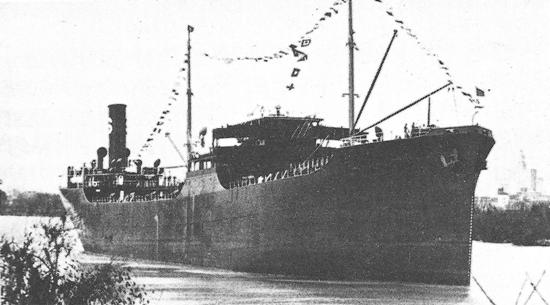
The Socony-Vacuum Oil Company tanker SS Mobiloil at its 1937 launching in Chester, Pennsylvania. Sunk by U-108 in 1942, the ship had not waited to join its assigned convoy. Photo courtesy Mobil.
After putting up a valiant defense, the tanker broke in half and sank, according to Ericwiberg.com. All 52 crew and passengers were rescued after about 86 hours in lifeboats, and the ship’s master was later convicted of violating convoy routing orders.
“The pressure of the convoys reached a peak in March 1943, when 98 ships were sunk,” adds the National Museums Liverpool. “Once again, the Allies appeared to be on the brink of defeat in the Atlantic.”
Learn more in Roughnecks of Sherwood Forest.
April 29, 2004 – Last Oldsmobile rolls off Assembly Line
The last Oldsmobile ever built (a four-door Alero GLS) left the company’s production line in Lansing, Michigan. Founded by Ransom E. Olds in 1897 as “Olds Motor Vehicle Company,” Olds sold America’s first mass-produced car, the Model R “Curved Dash,” from 1902 to 1907, according to Robert Domm in this 2009 book Michigan Yesterday & Today. In 1908, Oldsmobile joined Buick to become part of the newly established General Motors eight years after the first U.S. auto show.
April 30, 1929 – Marland Oil and Continental Oil become Conoco
After discovering several Oklahoma oil and gas fields, Marland Oil Company acquired Continental Oil Company to create a network of service stations in 30 states. Future Oklahoma Governor Ernest W. Marland founded Marland Oil in 1921; Continental Oil Company was founded in 1875 in Utah, where it refined oil into kerosene.
Headquartered in Ponca City, the new company retained the name Continental Oil, but adopted the well-known Marland red triangle trademark, replacing the “Marland Oils” text with “Conoco.” The company in 2002 merged with Phillips Petroleum, incorporated in 1917, to become ConocoPhillips (see ConocoPhillips Petroleum Museums).
April 30, 1955 – Landmen form Trade Association
The American Association of Professional Landmen (AAPL) organized in Fort Worth, Texas, as an association of petroleum lease negotiators. AAPL members research records to determine well ownership, locate mineral and land owners, and negotiate oil and natural gas leases, trades and contracts. With 12,000 members, AAPL assists in compliance with state and federal regulations, according to the association, which will host its 71th annual meeting June 18-20, 2025, in Kansas City, Mo.
May 1, 1860 – First West Virginia Oil Well
As the Civil War approached, Virginia’s petroleum industry began when John Castelli ”Cass” Rathbone completed an oil well near Burning Springs Run in what today is West Virginia. His well — drilled using a spring pole — reached 300 feet and began producing 100 barrels of oil a day.
Rathbone drilled more wells in the valley of the Little Kanawha River southwest of Parkersburg. It was the first petroleum boom to take place outside the Pennsylvania oilfields, revealed by the first U.S. well at Titusville a year earlier.
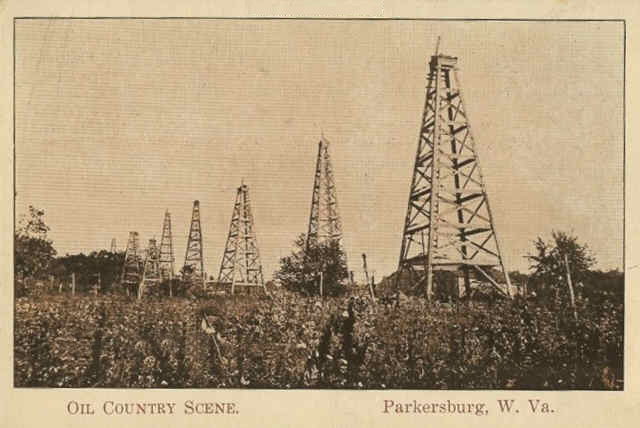
Following the 1860 oil discovery at Burning Springs, Appalachian drillers applied cable-tool technologies to drill deeper. 1869 postcard courtesy West Virginia Humanities Council.
By the end of 1860, the “Burning Springs Oil Rush” resulted in more than 600 oil leases registered in the Wirt County courthouse. Warehouses were built along the Little Kanawha River, which reached the Ohio River at Parkersburg.
“These events truly mark the beginnings of the oil and gas industry in the United States,” proclaimed West Virginia historian David McKain in 1994, adding that the region’s oil wealth helped bring about statehood in June 1863. Many of the new state’s politicians were “oil men — governor, senator and congressman — who had made their fortunes at Burning Springs.”
Visit West Virginia’s oil and gas museum in downtown Parkersburg.
May 1, 1916 – Harry Sinclair founds Sinclair Oil & Refining
Harry Ford Sinclair combined several depressed oil properties, five small refineries and many untested leases — all acquired at bargain prices. He began with $50 million in assets and borrowed another $20 million to form Sinclair Oil & Refining Corporation.
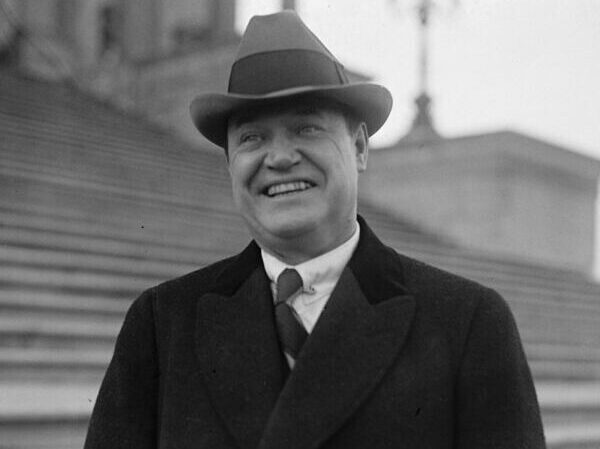
Sinclair Oil & Refining Corporation founder Harry Sinclair on the U.S. Capitol steps in January 1923. Photo Courtesy Library of Congress.
In its first 14 months, Sinclair’s New York-based company produced six million barrels of oil for a net income of almost $9 million ($258 million in 2024 dollars). The company’s petroleum refining capacity grew to 150,000 barrels of oil a day in 1932.
Although Sinclair was implicated in the 1920s Teapot Dome Scandal, his oil and refining company became one of the oldest continuous names in the petroleum industry. The “Dino” marketing icon Sinclair Oil dinosaur was exhibited at the 1933-1934 World’s Fair in Chicago. Sinclair died in 1956 at age 80.
May 1, 1931 – Railroad Commission limits East Texas Oil Production
The first proration order for the East Texas oilfield from the Texas Railroad Commission (RRC) took effect less than one year after the Daisy Bradford No. 3 well discovered the “Black Giant” of the Great Depression. With hundreds of wells producing almost one million barrels a day, oil prices had collapsed to as low as 10 cents per barrel. The commission’s order — unpopular with independent producers but enforced by Texas Rangers — limited production and stabilized prices.
May 1, 2001 – Oklahoma Plaza honors Oil Pioneers
The Sam Noble Museum at the University of Oklahoma in Norman dedicated a memorial to the state’s petroleum pioneers. “The individuals identified here are true Oklahoma Oil Pioneers whose work laid the groundwork for the oil and gas industry in a young state,” notes the Conoco Oil Pioneers of Oklahoma Plaza. “Their stories are not only inspirational, but serve as testaments to the extraordinary opportunities the early oil industry provided for individual achievements and public good.”

Wildcatter Tom Slick’s portrait in bronze bas-relief at the oil pioneers plaza of the Sam Noble Museum, University of Oklahoma, Norman.
Among the 60 honored are Tom Slick (1883-1930), Lloyd Noble (1896-1950), Robert S. Kerr (1896-1963) and service company pioneers George E. Failing (1889-1976), Erle P. Halliburton (1892-1957), and geophysicist John C. Karcher (1894-1978). “The history of the state of Oklahoma is inextricably linked with the remarkable history of the oil industry,” proclaimed Conoco Chairman Archie Dunham at the dedication.
May 2, 1921 – Oil discovered in Texas Panhandle
Following a series of discoveries revealing the giant Hugoton natural gas field in the Texas Panhandle, a well drilled in Carson County found an oilfield instead. Gulf Oil Company completed its wildcat well on the 6666 (the “Four Sixes”) Ranch of S.B. Burnett several miles east of the natural gas wells. The discovery attracted to Amarillo independent producers and oilfield service companies. In 1926, a giant oilfield was discovered northeast of Amarillo by A.P. “Ace” Borger, who founded the boom town of Borger. Learn more by visiting the Hutchinson County Historical Museum.
May 3, 1870 – Lantern with Two Spouts patented
Jonathan Dillen of Petroleum Centre, Pennsylvania, received a patent for his “safety derrick lamp,” a two-wicked lantern that became known as the “Yellow Dog” in America’s earliest oilfields. Dillen designed his lamp “for illuminating places out of doors, especially in and about derricks, and machinery in the oil regions, whereby explosions are more dangerous and destructive to life and property than in most other places.”
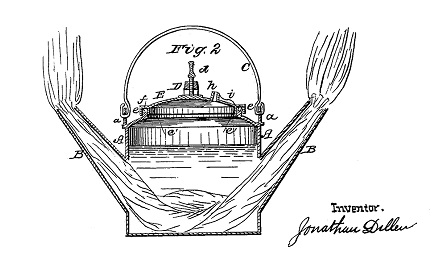
Patented in 1870, a popular two-wicked oilfield derrick lamp would become known as the “yellow dog.”
“My improved lamp is intended to burn crude petroleum as it comes from the wells fresh and gassy,” he added. How the once widely used lamp got its name has remained a mystery, but some say the two burning wicks resembled a dog’s glowing eyes at night.
Learn more in Yellow Dog – Oilfield Lantern.
May 4, 1869 – Offshore Drilling Platform Design patented
The first U.S. patent for an offshore drilling rig was issued to Thomas Rowland, owner of Continental Iron Works in Greenpoint, New York, for his “submarine drilling apparatus.” His remarkably advanced platform included a fixed, working platform for drilling in a water depth of up to 50 feet.
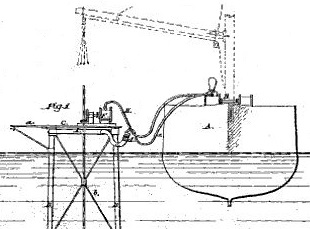
Thomas Rowland’s design for an offshore drilling platform with telescoping legs was ahead of its time.
Rowland’s anchored, four-legged tower concept would be adapted for modern platforms. His Continental Iron Works also became a world leader in gas fittings, welding, and oil tank design and construction (including a famous Civil War ironclad). The American Society of Civil Engineers in 1882 issued its first Thomas Fitch Rowland Prize awarded every year.
Learn more in Offshore Rig Patent.
_______________
Recommended Reading: The Secret of Sherwood Forest: Oil Production in England During World War II (1973); Michigan Yesterday & Today (2009); General Motors: A Photographic History
(1999); Oil And Gas In Oklahoma: Petroleum Geology In Oklahoma
(2013); Where it All Began: The story of the people and places where the oil & gas industry began: West Virginia and southeastern Ohio
(1994); “King of the Wildcatters:” The Life and Times of Tom Slick, 1883-1930
(2004); Offshore Pioneers: Brown & Root and the History of Offshore Oil and Gas
(1997). Your Amazon purchase benefits the American Oil & Gas Historical Society. As an Amazon Associate, AOGHS earns a commission from qualifying purchases.
_______________
The American Oil & Gas Historical Society (AOGHS) preserves U.S. petroleum history. Please become an AOGHS annual supporter and help maintain this energy education website and expand historical research. For more information, contact bawells@aoghs.org. Copyright © 2025 Bruce A. Wells. All rights reserved.




